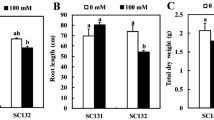Abstract
The understanding of crop physiological responses to salinity stress is of paramount importance for selection of genotypes with improved tolerance to this stress. Maize (Zea mays L.) hybrids Pioneer 32B33 and Dekalb 979 were grown in pots and subjected to three levels of salinity under four nitrogen levels to determine the role of nitrogen under saline conditions. Salinity stress effects on gas exchange characteristics and chlorophyll fluorescence of maize hybrids were evaluated under semi-controlled conditions. Under salinity stress, the changes in the net photosynthetic rate (P N), stomatal conductance (g s), and transpiration rate (E) were similarly directed: all decreased and were lower than in control at the higher salinity level (10 dS/m). Water use efficiency was increased with increasing salinity since transpiration was stronger depressed by salt than photosynthesis. Plants subjected to the lower level of salinity did not differ from control in tested characteristics. Nitrogen application ameliorated the effects of salinity.
Similar content being viewed by others
Abbreviations
- Chl:
-
chlorophyll
References
Surhay, R.A., Meltem, M., Rena, G., and Saeedeh, F., Effects of Salt Stress and Synthetic Hormone Polystimuline K on Photosynthetic Activity of Trianea bogotensis, Tr. J. Bot., 1998, vol. 22, pp. 19–23.
Munns, R., Comparative Physiology of Salt and Water Stress, Plant Cell Environ., 2002, vol. 25, pp. 239–250.
Taiz, L. and Zeiger, E., Plant Physiology, Sunderland, Massachusetts: Sinauer Ass. Publ., 1998.
Dionisio-Sese, M.L. and Tobita, S., Effects of Salinity on Sodium Content and Photosynthetic Responses of Rice Seedlings Differing in Salt Tolerance, J. Plant Physiol., 2000, vol. 157, pp. 54–58.
Lawlor, D.W. and Cornic, G., Photosynthetic Carbon Assimilation and Associated Metabolism in Relation to Water Deficits in Higher Plants, Plant Cell Environ., 2002, vol. 25, pp. 275–294.
Paterniani, E., Maize Breeding in Tropics, Crit. Rev. Plant Sci., 1990, vol. 9, pp. 125–154.
Amonkar, D.V. and Karmarkar, S.M., Nitrogen Uptake and Assimilation in Halophytes, Nitrogen Nutrition in Higher Plants, Srivastava, H.S. and Singh, R.P., Eds., New Dehli: Ass. Publ. Compt. Dehli, 1995, pp. 431–455.
Causin, H.F. and Barneix, A.J., Regulation of N Uptake in Wheat Plants: Effect of Root Ammonium Concentration and Amino Acids, Plant Soil, 1993, vol. 151, pp. 211–218.
Dubey, R.S. and Pessarakli, M., Physiological Mechanisms of Nitrogen Absorption and Assimilation in Plants under Stressful Conditions, Handbook of Plant and Crop Physiology, Pessarakli, M., Ed., 1995, pp. 605–625.
Strong, G.L., Bannister, P., and Burritt, D., Are Mistletoes Shade Plants? CO2 Assimilation and Chlorophyll Fluorescence of Temperate Mistletoes and Their Hosts, Ann. Bot., 2000, vol. 85, pp. 511–519.
Nieva, F.J.J., Castellanos, E.M., Figueroa, M.E., and Gil, F., Gas Exchange and Chlorophyll Fluorescence of C3 and C4 Salt Marsh Species, Photosynthetica, 1999, vol. 36, pp. 397–406.
Demmig, A., Adams, W.W., III, Barker, D.H., Logan, B.A., Bowling, D.R., and Verhoeven, A.S., Using Chlorophyll Fluorescence to Assess the Fraction of Absorbed Light Allocated to Thermal Dissipation of Excess Excitation, Physiol. Plant., 1996, vol. 98, pp. 253–264.
MSTAT Development Team. MSTAT User’ Guide: A Microcomputer Program for the Design Management and Analysis of Agronomic Research Experiments, East Lansing: Michigan State Univ., 1989.
Steel, R.G.D., Torrie, J.H., and Deekey, D.A., Principles and Procedures of Statistics: A Biometrical Approach, New York: McGraw-Hill, 1997, pp. 400–428.
Khavari-Nejad, R.A. and Mostofi, Y., Effects of NaCl on Photosynthetic Pigments, Saccharides, and Chloroplast Ultrastructure in Leaves of Tomato Cultivars, Photosynthetica, 1998, vol. 35, pp. 151–154.
Hernández, J., Campillo, A., Jiménez, A., Alarcon, J.J., and Sevilla, F., Response of Antioxidant Systems and Leaf Water Relation to NaCl Stress in Pea Plants, New Phytol., 1999, vol. 141, pp. 241–251.
Gupta, N.K., Gupta, S., and Kumar, A., Effect of Water Stress on Physiological Attributes and Their Relationship with Growth and Yield of Wheat Cultivars at Different Stages, J. Agron. Crop Sci., 2001, vol. 186, pp. 55–62.
Steduto, P., Albrizio, R., Giorio, P., and Sorrentino, G., Gas Exchange Response and Stomatal and Non-Stomatal Limitations to Carbon Assimilation of Sunflower under Salinity, Environ. Exp. Bot., 2000, vol. 44, pp. 243–255.
Maxwell, K. and Johnson, G.N., Chlorophyll Fluorescence — A Practical Guide, J. Exp. Bot., 2000, vol. 51, pp. 659–668.
Monneveux, P., Mekkaoui, M.E., and Xu, X., Physiological Basis of Salt Tolerance in Wheat Chlorophyll Fluorescence as a New Tool for Screening Tolerant Genotypes, Wheat Breeding. Prospects and Future Approaches, Varna, Bulgaria, 1990, pp. 1–33.
Netondo, G.W., Onyango, J.C., and Beck, E., Sorghum and Salinity: 2. Gas Exchange and Chlorophyll Fluorescence of Sorghum under Salt Stress, Crop Sci., 2004, vol. 44, pp. 806–811.
Krishna, Raj, S., Mawson, B.T., Yeung, E.C., and Thorpe, T.A., Utilization of Induction and Quenching Kinetics of Chlorophyll a Fluorescence for In Vivo Salinity Screening Studies in Wheat (Triticum aestivum vars. Kharchia-65 and Fielder), Can. J. Bot., 1993, vol. 71, pp. 87–92.
Xu, H.L., Gauthier, L., and Gosselin, A., Photosynthetic Response of Green House Tomato Plants to High Solution Electrical Conductivity and Low Soil Water Content, J. Hort. Sci., 1994, vol. 69, pp. 821–832.
Ashraf, M., Relationships between Growth and Gas Exchange Characteristics in Some Salt Tolerant Amphidiploid Brassica Species in Relation to Their Diploid Parents, Environ. Exp. Bot., 2001, vol. 45, pp. 155–163.
Greenway, H. and Munns, R., Mechanisms of Salt Tolerance in Non-Halophytes, Annu. Rev. Plant Physiol., 1980, vol. 31, pp. 149–190.
Author information
Authors and Affiliations
Corresponding author
Additional information
This text was submitted by the authors in English.
Rights and permissions
About this article
Cite this article
Akram, M., Ashraf, M.Y., Jamil, M. et al. Nitrogen application improves gas exchange characteristics and chlorophyll fluorescence in maize hybrids under salinity conditions. Russ J Plant Physiol 58, 394–401 (2011). https://doi.org/10.1134/S1021443711030022
Received:
Published:
Issue Date:
DOI: https://doi.org/10.1134/S1021443711030022



